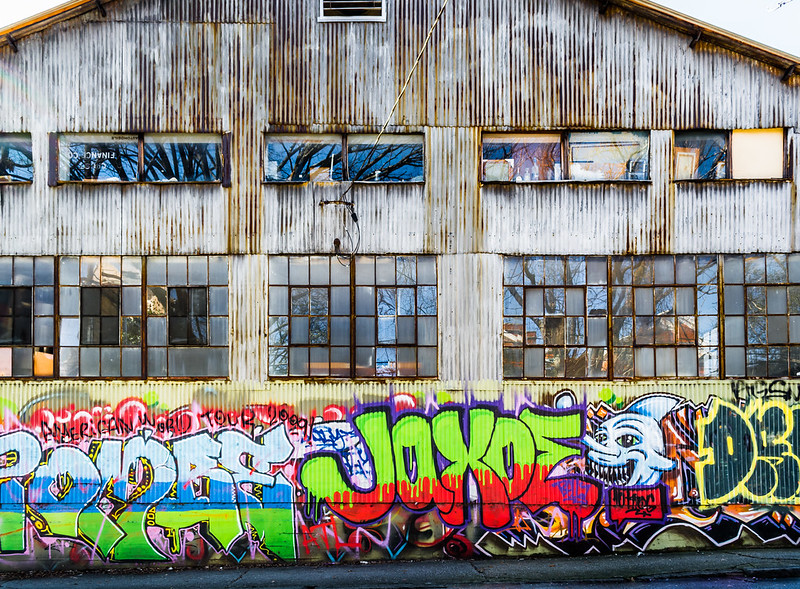In the category of “interesting things I’ve never thought much about,” Gerald Kerr-Wilson and Kiera Boyd (Fasken) popped up in a Google alert I have set up recently with a short piece on whether graffiti is protected by copyright. It’s short and cogent.
On search to fill in some holes, I’ve discovered this is kind of a little cottage industry for law firm blogs shoring up their SEO; a quick search shows at least a dozen very similar articles treading much the same ground:
- the Copyright Act doesn’t require that work be lawful to have copyright protection;
- issues may arise if graffiti is reproduced, including in the background of other works, and that partial destruction of graffiti may infringe the author’s moral rights.
Challenges when using graffiti are partially answered in the first case by incidental use (s30.7 of the Act) and whether the graffiti could be considered permanent “artistic craftsmanship” (s 32.2(1)(b)). In the second case, it’s possible (no case has ever come up) that protection may exist but in a limited form, like for obscene materials (Aldrich v One Stop Video Ltd, [1987] BCJ No 1035).
Fair dealing isn’t much of a defense; it’s highly contextually specific, but it would be rare(ish) for something to be covering graffiti in an academic/analysis context that gets to the point where it’s worth pursuing a claim. Plus, attribution is part of the consideration — impossible with most graffiti, which I get into below.
They don’t address two questions I think are really compelling, though.
First, that to claim authorship you’d have to in many cases confess to a crime; in Canada, this would be “mischief”, per s 430(1) of the Criminal Code:
Mischief
430 (1) Every one commits mischief who wilfully
(a) destroys or damages property;
(b) renders property dangerous, useless, inoperative or ineffective;
(c) obstructs, interrupts or interferes with the lawful use, enjoyment or operation of property; or
(d) obstructs, interrupts or interferes with any person in the lawful use, enjoyment or operation of property.
Criminal Code, s430(1)
Generally, assuming that most graffiti results in <$5K of damage, this would make you liable to imprisonment for a term not exceeding two years, or punishable on summary conviction (s 430(4)).
There’s a six-month limitation to most cases of mischief (s 786(2) of the Code), so depending on how rapacious you are as a tagger* and how far in the past you bombed*, your comfort level in coming forward may vary.
Second question: how do you prove you’re the author of graffiti? Clearly, you’re not going to register it. I can only imagine that in many cases, the artist has taken steps _not_ to be identified. On a cursory search, I can’t find much in terms of court cases that have hinged on authors proving authorship over pseudonymous work. The one thing — a 2014 story about Alexandre Veilleux, a Montreal graffiti artist who sued Radio-Canada (French-language CBC) for $45,000 for using buildings tagged with his graffiti under the name “Alex Scaner” in a TV show called 30 Vies. Article here (in French). Nothing seems to have reached to the point that it’s captured in CanLII, so either it was dropped or settled pre-court.1Also, Quebec is a civil law jurisdiction, so YMMV in the rest of Canada.
Via Teresa Scassa’s blog, a 2013 account of an Orillia-area art gallery that pulled an exhibit of photos of graffiti taken in Barcelona; in the Scassa blog, there’s also mention of a 2008 incident with a Toronto gallery taking down a graffiti photo exhibit. 2An aside: bitrot has eaten some of the above articles, and I can’t say enough how much I appreciate the good people at archive.org and the Wayback Machine for archiving things like this. If you have a few bucks this holiday season, consider supporting them.
It’s also worth noting the the latter article includes a photo of somebody in the gallery, looking at the photos that reproduce the graffiti — I’d assume that “Patanne“, the photographer there as credited in this other article, is now also subject to the same complaints as Karp, the Moore Gallery artist. It’s turtles all the way down.
Banksy, the world’s most famous graffiti artist, has failed to assert copyright over his work in the past – in part because he wanted to preserve his pseudoanonymity.
Fun woolgathering, but without much to hang a hat on. A little woolgathering on a Sunday morning is never a bad thing, though.
*Am I qualified to use graffiti lingo? Well, I did subscribe to Juxtapoz magazine for, like, two years in the mid-aughts, so I have exactly $72 worth of cred.
Music:
- Various Artists, “The Faithful: A Tribute to Marianne Faithfull”
- Sick Boss, “Businessless”
- Various Artists/Tycho, “Back to Mine: Tycho”
- 1Also, Quebec is a civil law jurisdiction, so YMMV in the rest of Canada.
- 2An aside: bitrot has eaten some of the above articles, and I can’t say enough how much I appreciate the good people at archive.org and the Wayback Machine for archiving things like this. If you have a few bucks this holiday season, consider supporting them.
